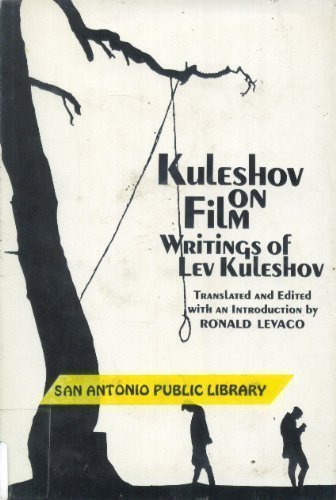Kuleshov on Film: Writings by Lev Kuleshov pdf free
Par tsosie theodore le mercredi, septembre 28 2016, 05:57 - Lien permanent
Kuleshov on Film: Writings by Lev Kuleshov. Lev Vladimirovich Kuleshov, Ronald Levaco

Kuleshov.on.Film.Writings.by.Lev.Kuleshov.pdf
ISBN: 0520026594,9780520026599 | 121 pages | 4 Mb

Kuleshov on Film: Writings by Lev Kuleshov Lev Vladimirovich Kuleshov, Ronald Levaco
Publisher: Univ of California Pr
The idea that editing constitutes the “essence” of film art originated with the Russian director and theoretician Lev Kuleshov (1899-1970) who experimented with montage in the 1920s in an almost scientific fashion and is also one of the key exponents of the 'film as language' idea. In order to proceed with basic film techniques I felt that a short exposition on the 'Kuleshov effect' was required. Lev kuleshov was among the very first to theorise about the relatively young medium of the cinema in the 1920s. It then goes on to explain that it was Lev Kuleshov (1899-1970) who proposed that cinema spectators automatically connect and 'make sense' of movie sequences that are edited together. The younger director and theorist Lev Kuleshov, who believed in the central importance of editing to the filmmaking process, ran an influential workshop there that helped to birth montage theory. MEDIUM: Short experimental film. Kuleshov's students included In the next few years, Kuleshov's former students would produce three now-classic revolutionary entertainment films: Eisenstein's Strike (1924) and Battleship Potemkin (1925), and Pudovkin's own Mother (1926). Lev Kuleshov and also Sergei Eisenstein were two film makers (both Russian) to really step this up. If you already read my thoughts about this film on IMDb, there's no need to read this, since it's basically the same stuff I already said there (albeit with spoiler stuff). The Kuleshov effect is a film editing technique that was recognised and demonstrated by Russian filmmaker Lev Kuleshov between 1910-1920 during his montage experiments. Like modern poets who learned their craft writing sonnets, the discipline was good for directors who carried those techniques into the sound era. Russian filmmaker Lev Kuleshov demonstrated the montage effect in the 1910s and 1920s. The 'Kuleshov effect' refers to the Soviet filmmaker Lev Kuleshov who saw editing and film as an art form. These studies began a continuous line of European philosophical works on film that stretched through to today's writings by Jacques Rancière and Slavoj Žižek. Nevertheless, Hitch didn't learn those lessons overnight. Through-out the films that Kuleshov was creating they contained propaganda a form of information that is biased to support a specific view (in this issue it was a government, political view). By the Law (Lev Kuleshov, 1926). The Kuleshov Effect is the result of a very famous film experiment done by Lev Kuleshov in the 1910s and 1920s.